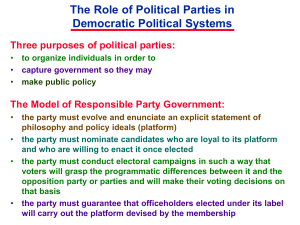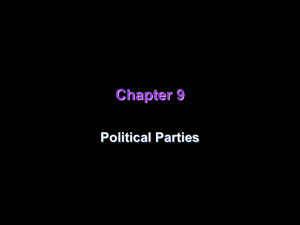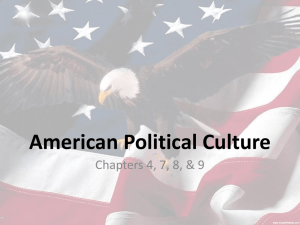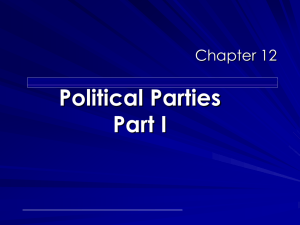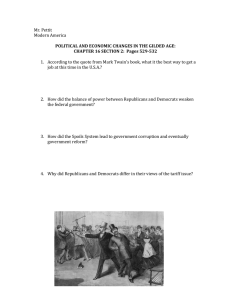2018 Midterm Study Guide
advertisement
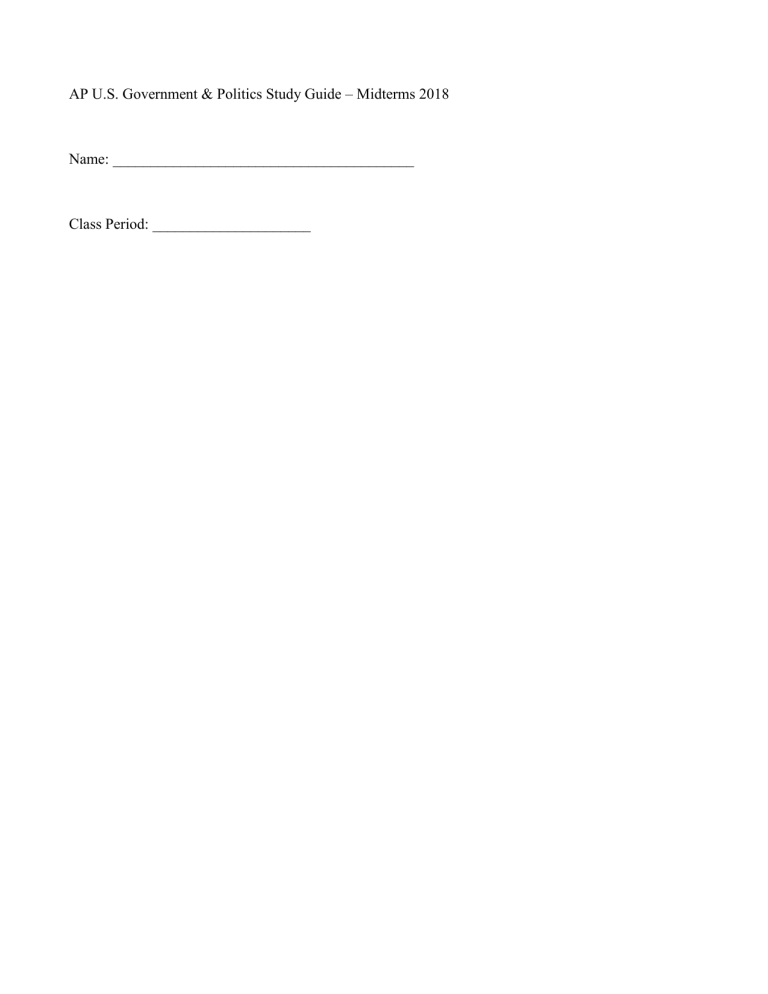
AP U.S. Government & Politics Study Guide – Midterms 2018 Name: ________________________________________ Class Period: _____________________ Public Opinion REVIEWING THE CHAPTER CHAPTER FOCUS The purpose of this chapter is to explore what we mean by public opinion and to ask what sorts of effects public opinion has on our supposedly democratic form of government. After reading and reviewing the material in this chapter, you should be able to do each of the following: 1. List the sources of our political attitudes, and indicate which are the most important ones. Assess the influence of various religious traditions on political attitudes. 2. Explain why there is no single cleavage between liberals and conservatives in this country and why there are crosscutting cleavages. Explain the significance of these facts. Assess the significance of race in explaining political attitudes. 3. Define political ideology and state why most Americans do not think ideologically. Summarize the liberal positions on the economy, civil rights, and political conduct. Describe the major policy packages in the Democratic Party, and indicate which groups in the Democratic coalition can be identified with each package. 4. Identify which elite groups have become liberal, and compare their current attitudes with the past political preferences of these groups. Discuss the “new class” theory as an explanation for changes in attitudes. Analyze why these changes are causing strain in the political party system. STUDY OUTLINE I. II. Introduction A. Lincoln and the Gettysburg Address … “of the people, by the people, for the people” 1. Yet the federal government’s budget is not balanced 2. Yet the people have opposed busing 3. Yet the ERA was not ratified 4. Yet most Americans favor term limits for Congress B. Why government policy and public opinion may appear to be at odds 1. Government not intended to do “what the people want” a) Framers of Constitution aimed for substantive goals b) Popular rule was only one of several means toward these goals c) Large nations feature many “publics” with many “opinions” (1) Framers hoped no single opinion would dominate (2) Reasonable policies can command support of many factions 2. Limits on effectiveness of opinion polling; difficult to know public opinion What is public opinion? A. Influences and limitations 1. Position taking on nonexistent legislation, contradictory opinions and inexplicable shifts 2. Political scientists and polling a) 1940s: only a small group of citizens appeared to be informed b) Later studies: many use limited information (cues) to support candidates, parties and policies that reflect their own personal values B. How polling works 1. Sampling techniques 2. Sampling error 3. High accuracy rates―in presidential elections C. How opinions differ 1. Saliency: some opinions matter more than others 2. Stability: some opinions are more volatile than others 3. Policy congruence: some opinions are reflected in government policy more closely than others 4. Additional observations a) Political socialization matters b) Elite and mass opinion differ III. Political socialization A. The family 1. Child absorbs party identification of family but becomes more independent with age 2. Much continuity between generations 3. Declining ability to pass on identification a) Younger voters exhibit less partisanship; more likely to be independent b) Meaning of partisanship unclear in most families; less influence on policy preferences c) Age related differences in opinions on issues (gay marriage, women’s rights, vouchers, etc.) d) Few families pass on clear ideologies B. Religion 1. Religious traditions affect families a) Catholic families somewhat more liberal b) Protestant families more conservative c) Jewish families decidedly more liberal 2. Two theories on differences a) Social status of religious group b) Content of religion’s tradition C. The gender gap 1. Journalists note women have “deserted” Republican candidates a) It would be more correct to say men have “deserted” Democratic candidates b) Difference (“gap”) in the political views of men and women has existed for a long time c) Presents problems for both parties 2. Females and voting a) Turnout (1) Right to vote obtained in 1920, Nineteenth Amendment (2) Low turnout rate until 1980 b) Vote choice (1) More likely to favor Democratic candidates (2) Leaning also evident in mid-term congressional elections (3) Reflection of differences in stances on issues (a) Banning handguns (b) Increased spending on anti-poverty programs (c) Limiting defense spending (d) “Issue importance” rankings D. Schooling and information 1. Much research links college education to liberal attitudes 2. Relationship was especially strong for students at high prestige institutions 3. Increased schooling also correlated with higher levels of voting and political participation 4. Generalizations less applicable today a) Some evidence to suggest college students are more conservative than they used to be (1) Concerns about “political correctness” (2) Conservative students more vocal on campus (3) Increase in enrollment of religious colleges and universities b) Political participation among young people is down c) Decline in reading of newspapers and newsmagazines IV. Cleavages in public opinion A. Social class: less important in United States than in Europe 1. More important in 1950s on unemployment, education, housing programs 2. Less important in 1960s on poverty, health insurance, Vietnam, jobs 3. Why the change? a) Education: occupation depends more on schooling b) Noneconomic issues now define liberal and conservative B. Race and ethnicity 1. African Americans: voting patterns and positions on issues a) African Americans are overwhelmingly Democratic (1) Younger African Americans are more likely than older ones to identify with the Republican Party (2) Younger African Americans more likely than older ones to support school vouchers b) Sharp differences between attitudes of whites and African Americans on public policies (1) Blacks more likely to support affirmative action (2) Blacks more likely to think the criminal justice system is biased against them (3) Blacks more likely to oppose use of military force and less likely to think we should all be willing to fight for our country (4) Blacks less likely to think believing in God is essential for a person to be moral c) Areas of agreement (1) Getting tough on crime (2) Abortion (3) Dependency on governmental aid (4) The power to succeed 2. Latinos and Asians a) Latinos are the largest minority in America, but there are few studies of their opinions (1) More likely to be Democrat, although not as much as African Americans (2) Somewhat more liberal than whites or Asian Americans, although not as liberal as African Americans (a) Favor big government (b) Think the Democratic Party cares more about them (3) b) C. V. Those from Mexico are more Democrat, those from Cuba are more Republican, those from Puerto Rico somewhere in between (4) Hispanics in Texas are more conservative than Hispanics in California (5) Differences between native-born and foreign born ones Asians (1) Asian Americans identify more strongly with the Republican Party than whites (2) Views on military and welfare programs, prayer in schools, and the death penalty are more similar to those of whites than those of blacks or Hispanics (3) Japanese Americans are more conservative whereas Korean Americans are more liberal Region 1. Southerners are more conservative than northerners on military and civil rights issues but differences are fading overall 2. Southern lifestyle different 3. Lessening attachment to Democratic Party Political ideology A. Consistent attitudes 1. Ideology: patterned set of political beliefs about who ought to rule, their principles and policies 2. Measuring ideology a) Self-identification b) Searching for “constraint” 3. Recent surveys a) Moderates are the largest group among Americans b) Conservatives are second, liberals are the smallest group B. Concerns about self-identification in surveys 1. Most Americans do not use the words liberal and conservative on their own and many do not have a clear idea of what they mean 2. Inconsistency can be cause by a variety of factors a) Nature of a problem may have changed b) Wording of questions may have changed c) People may have contradictory preferences 3. Some respondents will hide their ideology C. Mass ideologies: a typology 1. Increasingly, searching for “constraint” is preferred 2. Nine different groups identified by certain key values in one popular survey a) Liberals and “disadvantaged Democrats” constitute one in three voters and over one quarter of the general public b) Conservatives and Republican “enterprisers” comprise nearly one in two registered voters and over 40 percent of the general population c) One in five Americans are “disaffected” or “bystanders” D. Political elites 1. Definition: those who have a disproportionate amount of some valued resource 2. Elites, or activists, display greater ideological consistency a) More information than most people b) Peers reinforce consistency and greater differences of opinion than one finds among average voters 3. Greater ideological consistency of elites can be seen in Congress a) Democratic members tend to be consistently liberal b) Republican members tend to be consistently conservative VI. Political elites, public opinion, and public policy A. Elites influence public opinion in three ways 1. Raise and form political issues 2. State norms by which to settle issues, defining policy options 3. Elite views shape mass views B. Limits to elite influence on the public 1. Elites do not define problems 2. Many elites exist; hence many elite opinions Political Participation REVIEWING THE CHAPTER CHAPTER FOCUS This chapter reviews the much-discussed lack of voter turnout and other forms of political participation in the United States, and concludes that individual Americans may not be at fault for their seeming nonparticipation but that other factors may be at work. After reading and reviewing the material in this chapter, you should be able to do each of the following: 1. Explain why the text believes that the description, the analysis, and the proposed remedy for low voter turnout rates in this country are off base. 2. Compare the way turnout statistics are tabulated for this country and for other countries, and explain the significance of these differences. 3. Describe how the control of elections has shifted from the states to the federal government, and explain what effects this shift has had on blacks, women, and youths. 4. State both sides of the debate over whether voter turnout has declined over the past century, and describe those factors that tend to hold down voter turnout in this country. 5. List and explain Nie and Verba’s four categories of political participation. 6. Discuss those factors that appear to be associated with high or low political participation. 7. Compare participation rates in various forms of political activity here and in other countries. STUDY OUTLINE I. II. Introduction A. 80 percent voter turnout in European countries B. Low turnout in America blamed on apathy C. Calls for action by government or private groups to mobilize voters A closer look at nonvoting A. Alleged problem: low turnout compared with Europeans, but this compares registered voters with the eligible adult population B. Common explanation: voter apathy on Election Day, but the real problem is low registration rates C. Proposed solution: get-out-the-vote drives 1. 2004 study found little impact in relation to such efforts 2. If anything, get-out-the-vote appeals may mobilize those who usually vote in low turnout elections D. Apathy not the only cause of nonregistration 1. Costs here versus no costs in European countries where registration is automatic 2. Motor-voter law of 1993 (which took effect in 1995) a) 630,000 new voters in two months b) Accounted for almost 40 percent of applications in 2001–2002 c) Scant evidence of impact on turnout or election outcomes E. Voting is not the only way of participating III. The rise of the American electorate A. From state to federal control 1. Initially, states decided nearly everything 2. This led to wide variation in federal elections 3. Congress has since reduced state prerogatives a) 1842 law: House members elected by district b) Suffrage to women c) Suffrage to blacks d) Suffrage to eighteen- to twenty-year-olds e) Direct popular election of U.S. senators 4. Black voting rights a) Fifteenth Amendment gutted by Supreme Court as not conferring a right to vote b) Southern states then use evasive strategies (1) Literacy test (2) Poll tax (3) White primaries (4) Grandfather clauses (5) Intimidation of black voters c) Most of these strategies ruled out by Supreme Court d) Major change with 1965 Voting Rights Act; black vote increases 5. Women’s voting rights a) Western states permit women to vote b) Nineteenth Amendment ratified 1920 c) No dramatic changes in outcomes 6. Youth vote a) Voting Rights Act of 1970 b) Twenty-sixth Amendment ratified 1971 c) Lower turnout rate initially and no evident party loyalty d) Turnout remains lower than that of other age groups although rates of political participation generally are at an all time high 7. National standards now govern most aspects B. Voting turnout 1. Debate over declining percentages: two theories a) The percentages are real and the result of a decline in popular interest in elections and competitiveness of the two parties (1) Parties originally worked hard to increase turnout among all voters (2) The election of 1896 locked Democrats in the South and Republicans in the North (3) Lopsided Republican victories caused citizens to lose interest (4) Leadership in the major parties became conservative and resisted mass participation b) The percentages represent an apparent decline induced, in part, by more honest ballot counts of today (1) Parties once printed ballots (2) Ballots cast in public (3) Parties controlled counting c) Most scholars see several reasons for some real decline (1) Registration more difficult: longer residency, educational qualifications, and discrimination (2) Continuing drop after 1960 cannot be explained (3) Refinement of VAP data to VEP data also reveals a decline d) Universal turnout probably would not alter election outcomes IV. Who participates in politics? A. Forms of participation 1. Voting the most common, but 8 to 10 percent misreport it 2. Verba and Nie’s six types of participants a) Inactives b) Voting specialists c) Campaigners d) Communalists e) Parochial participants f) Complete activists B. Causes of participation 1. Schooling, or political information, more likely to vote 2. Church-goers vote more 3. Men and women vote same rate 4. Race a) Black participation lower than that of whites overall b) But controlling for SES, higher than whites 5. Level of trust in government? a) Studies show no correlation 6. Difficulty of registering: as turnout declines, registration gets easier 7. Several small factors decrease turnout a) More youths, blacks, and other minorities b) Decreasing effectiveness of parties c) Remaining impediments to registration d) Voting compulsory in other nations e) Ethnic minorities encounter language barriers, whereas blacks are involved in nonpolitical institutions f) May feel that elections do not matter 8. Democrats and Republicans fight over solutions a) No one really knows who would be helped b) Nonvoters tend to be poor, black, and so on c) But an increasing percentage of college graduates are also not voting d) Hard to be sure that turnout efforts produce gains for either party: Jesse Jackson in 1984 C. The meaning of participation rates 1. Americans vote less but participate more a) Other forms of activity becoming more common b) Some forms more common here than in other countries 2. Americans elect more officials than Europeans do and have more elections 3. U.S. turnout rates heavily skewed to higher status; meaning of this is unclear Political Parties REVIEWING THE CHAPTER CHAPTER FOCUS This chapter provides a fairly detailed exploration of one unique aspect of American politics: the twoparty system that has evolved in the United States. After reading and reviewing the material in this chapter, you should be able to do each of the following: 1. Define the term political party and contrast the structures of the European and American parties, paying particular attention to the federal structure of the American system and the concept of party identification. 2. Trace the development of the party system through its four periods, and offer reasons that parties have been in decline since the New Deal period. 3. Describe the structure of a major party and distinguish powerful from powerless party organs. 4. Define intraparty democracy and state its effect on the last few Democratic nominating conventions in the last few contests. Evaluate the relative strengths of state party bosses in recent years, and discuss the increasing importance of primaries in relation to the boss system at conventions. 5. Describe the machine, discuss its functions, and trace its decline. Contrast its structure with that of ideological and reform parties. 6. Offer two explanations for the persistence of the two-party system. Explain why minor parties form, and discuss different kinds of parties. Analyze why they are so rarely successful. 7. Describe some of the issue differences between delegates at Democratic and Republican conventions, and indicate whether there are major differences between the parties. Compare these differences with those between members of the rank and file voters. STUDY OUTLINE I. Introduction A. Swings in recent elections 1. Democratic success in 2006 mid-term congressional elections, after years of Republican success 2. Republican success in 2002 B. 2006 swings were the result of a general desire for change (as opposed to agreement with the policies of the Democratic Party) C. If anything, the relevance of the parties is declining—a serious problem for our representative democracy II. Parties here and abroad A. The American context 1. A party is a group that seeks to elect candidates to public office by supplying them with a label 2. American parties: historical development a) American parties are the oldest in the world b) New parties come and go, but two dominate the process c) Do not matter as much as they once did (1) They used to mobilize voters (2) Identification used to involve a serious commitment d) Why the decline? (1) Laws and rules (2) Voters have lost a sense of commitment (3) Decentralization has made the weakening uneven 3. Relevant arenas a) A label in the minds of the voters b) Set of leaders in government c) Organization recruiting and campaigning 4. American parties have become weaker in all three arenas a) As labels: more independents b) As organizations: much weaker since the 1960s c) As sets of leaders: the organization of Congress less under their control B. Reasons for differences from European parties 1. Federal system decentralizes power a) Early on, most people with political jobs worked for state and local governments b) National parties were coalitions of local parties c) As political power becomes more centralized, parties become weaker still 2. Parties closely regulated by state and federal laws 3. Candidates chosen through primaries, not by party leaders 4. President elected separately from Congress 5. Political culture a) Parties unimportant in life; Americans do not join or pay dues b) Parties separate from other aspects of life III. The rise and decline of the political party A. The Founding (to the 1820s) 1. Founders’ dislike of factions 2. Emergence of Republicans, Federalists: Jefferson versus Hamilton a) Loose caucuses of political notables b) Republicans’ success and Federalists’ demise 3. No representation of clear economic interests B. The Jacksonians (to the Civil War) 1. Political participation a mass phenomenon a) More voters to reach b) Party built from the bottom up c) Abandonment of presidential caucuses d) Beginning of national conventions to allow local control C. The Civil War and sectionalism 1. Jacksonian system unable to survive slavery issue 2. New Republicans become dominant because of a) Civil War and Republicans on Union side b) Bryan’s alienation of northern Democrats in 1896 In most states one party predominates a) Party professionals, or “stalwarts,” one faction in GOP b) Mugwumps, Progressives, or “reformers” another faction (1) Balance of power at first (2) Diminished role later D. The era of reform 1. Progressive push measures to curtail parties a) Primary elections b) Nonpartisan elections c) No party-business alliances d) Strict voter registration requirements e) Civil service reform f) Initiative and referendum elections 2. Effects a) Reduction in worst forms of political corruption b) Weakening of all political parties IV. Party realignments A. Definition: sharp, lasting shift in the popular coalition supporting one or both parties B. Occurrences: change in issues 1. 1800: Jeffersonians defeated Federalists 2. 1828: Jacksonian Democrats came to power 3. 1860: Whigs collapsed; Republicans won 4. 1896: Republicans defeated Bryan 5. 1932: FDR Democrats came to power C. Kinds of realignments 1. Major party disappears and is replaced (1800, 1860) 2. Voters shift from one party to another (1896, 1932) D. Clearest cases 1. 1860: slavery 2. 1896: economics 3. 1932: depression E. 1980 not a realignment 1. Expressed dissatisfaction with Carter 2. Also left Congress Democratic F. 1972–1988: shift in presidential voting patterns in the South 1. Fewer Democrats, more Republicans, more independents 2. Independents vote Republican 3. Now close to fifty-fifty Democratic, Republican 4. Party dealignment, not realignment G. Party decline; evidence for it 1. Fewer people identify with either party 2. Increase in ticket splitting V. The national party structure today A. Parties similar on paper 1. National convention ultimate power; nominates presidential candidate 2. National committee composed of delegates from states 3. Congressional campaign committees 4. National chair manages daily work 3. B. Party structure diverges in the late 1960s 1. RNC moves to bureaucratic structure; a well-financed party devoted to electing its candidates 2. Democrats move to factionalized structure to distribute power 3. RNC uses computerized mailing lists to raise money a) Money used to run political consulting firm b) Legal and financial advice, issue research, provide information on voting trends, conduct advertising campaigns, etc. 4. Democrats copied the Republican strategy and set new records for fund raising 5. The current competition for soft money and record spending C. National conventions 1. National committee sets time and place; issues call setting number of delegates for each state 2. Formulas used to allocate delegates a) Democrats shift the formula away from the South to the North and West b) Republicans shift the formula away from the East to the South and Southwest c) Result: Democrats move left, Republicans right 3. Democratic formula rewards large states and Republican-loyal states 4. Democrats set new rules a) In the 1970s the rules changed to weaken party leaders and increase the influence of special interests b) Hunt commission in 1981 reverses 1970s rules by increasing the influence of elected officials and by making convention more deliberative 5. Consequence of reforms: parties represent different set of upper-middle-class voters a) Republicans represent traditional middle class b) Democrats represent the “new class” c) Democrats hurt because the traditional middle class closer in opinions to most citizens 6. To become more competitive, Democrats adopt rule changes a) In 1988 the number of super-delegates increased and special interests decreased b) In 1992 three rules: winner-reward system, proportional representation, and states that violate rules are penalized 7. Conventions today only ratify choices made in primaries VI. State and local parties A. The machine 1. Recruitment via tangible incentives 2. High degree of leadership control 3. Abuses a) Gradually controlled by reforms b) But machines continued 4. Both self-serving and public regarding 5. Winning above all else B. Ideological parties 1. Principle above all else 2. Usually outside Democrats and Republicans 3. But some local reform clubs 4. Reform clubs replaced by social movements C. Solidary groups 1. Most common form of party organization 2. Members motivated by solidary incentives 3. Advantage: neither corrupt nor inflexible 4. Disadvantage: not very hard working D. Sponsored parties 1. Created or sustained by another organization 2. Example: Detroit Democrats controlled by UAW 3. Not very common E. Personal following 1. Examples: Kennedys, Curley, Talmadges, Longs 2. Viability today affected by TV and radio 3. Advantage: vote for the person 4. Disadvantage: takes time to know the person VII. The two-party system A. Rarity among nations today B. Evenly balanced nationally, not locally C. Why such a permanent feature? 1. Electoral system: winner-take-all and plurality system 2. Opinions of voters: two broad coalitions a) Most Americans see a difference between Democrats and Republicans (1) Democrats favored on issues such as poverty, the environment and health care (2) Republicans favored on issues such as national defense, foreign trade and crime (3) Parties evenly split on issues such as the economy and taxes b) Mass perceptions can change (education, national defense, immigration policy, etc.) 3. For many years, the laws of many states VIII. Minor parties A. Ideological parties: comprehensive, radical view; most enduring Examples: Socialist, Communist, Libertarian B. One-issue parties: address one concern, avoid others Examples: Free Soil, Know-Nothing, Prohibition C. Economic protest parties: regional, oppose depressions Examples: Greenback, Populist D. Factional parties: from split in a major party Examples: Bull Moose, Henry Wallace, American Independent E. Movements not producing parties; either slim chance of success or major parties accommodate Examples: civil rights, antiwar, labor F. Factional parties have had greatest influence 1. 1992 and 1996, Ross Perot 2. 2000 and 2004, Ralph Nader IX. Nominating a president A. Two contrary forces: party’s desire to win motivates it to seek an appealing candidate, but its desire to keep dissidents in party forces a compromise to more extreme views B. Are the delegates representative of the voters? 1. Democratic delegates much more liberal 2. Republican delegates much more conservative 3. X. Explanation of this disparity not quota rules: quota groups have greater diversity of opinion than do the delegates C. Who votes in primaries? 1. Primaries now more numerous and more decisive a) Stevenson and Humphrey never entered a primary b) By 1992: forty primaries and twenty caucuses 2. Little ideological difference between primary voters and rank-and-file party voters 3. Caucus: meeting of party followers at which delegates are picked a) Only most-dedicated partisans attend b) Often choose most ideological candidate: Jackson, Robertson in 1988 D. Who are the new delegates? 1. However chosen, today’s delegates a new breed unlikely to resemble average citizen: issue-oriented activists 2. Advantages of new system a) Increased chance for activists within party b) Decreased probability of their bolting the party 3. Disadvantage: may nominate presidential candidates unacceptable to voters or rank and file Parties versus voters A. Democrats: win congressional elections but lose presidential contests 1. Candidates are out of step with average voters on social and tax issues 2. So are delegates, and there’s a connection B. Republicans had the same problem with Goldwater (1964) C. Rank-and-file Democrats and Republicans differ on many political issues, but the differences are usually small D. Delegates from two parties differ widely on these same issues 1. 1996 conventions a) Few conservatives at Democratic convention b) Few liberals at Republican convention 2. Formula for winning president a) Nominate candidates with views closer to the average citizen (e.g., 1996 election) b) Fight campaign over issues agreed on by delegates and voters (e.g., 1992 election)
